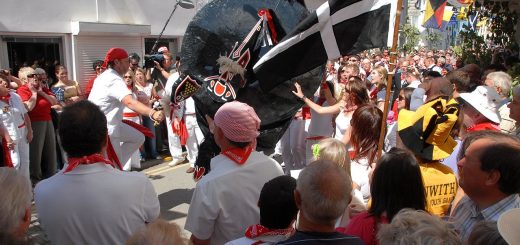Fortingall Yew Tree
The ancient remains of the yew tree which survives within its own walled enclosure in Fortingall Churchyard is claimed to be the oldest living tree in Europe. From outside the walled enclosure the spread of the tree looks impressive and you would anticipate a huge trunk, unfortunately souvenir worship and the fact that the inner tree has rotted centuries ago has left what looks like individual small trees around the edges of where the main trunk should be.
 These offshoots are vigorous enough, and a row of round dowels mark the trunks once impressive girth on the bare earth beneath the canopy. These markers give an impression of how vast it would even a few hundred years ago.
These offshoots are vigorous enough, and a row of round dowels mark the trunks once impressive girth on the bare earth beneath the canopy. These markers give an impression of how vast it would even a few hundred years ago.
The tree has appeared in literature several times over the last 250 years, the first reference in 1769 by Hon. Daines Barrington when the circumference of the trunk was measured at 56 feet. In 1770 it was noted that the tree huge trunk had decayed to ground level.
A wall was erected around the tree as a protective measure but by 1833 visitors and souvenir hunters had denuded the tree further by taking pieces of the tree either as souvenirs in themselves, or to carve objects that would have the pedigree of being carved from the ancient Fortingall Yew. Contemporary pictures show it to have been an impressive semi circular wall of deadwood resembling a crown, with newer branches and shoots splayed from the circumference of dead wood.
One ancient practice that may have damaged the tree was the lighting of fires during the Beltane festival. It was also noted in 1854 that funeral processions passed through the tree on their way to the church. It has been surmised that this site was a place of worship for our ancestors, and perhaps the lighting of Beltane fires was one survival although now the exact practices have been lost to antiquity.
In legend Pontius Pilate is said to be from the area and to have played under the tree, a curious tradition as both culturally and geographically this area was a long way from the Roman empire. Julius Caesar’s army invaded Britain twice in 55 and 54 BC, the second as an inroad with aligned Celtic kings that did not penetrate very far into mainland Britain. There was a more successful invasion by Claudius in AD 43, which marked the beginnings of the Romano British period. It is probable that the legend has modern origins perhaps dating from the time of the church.
The area has many archaeological remains the closest being the Bronze Age Carn na Marbh, and some standing stones nearby.




Recent Comments